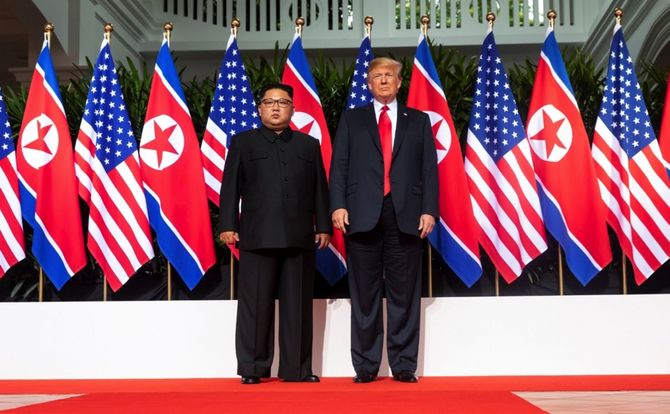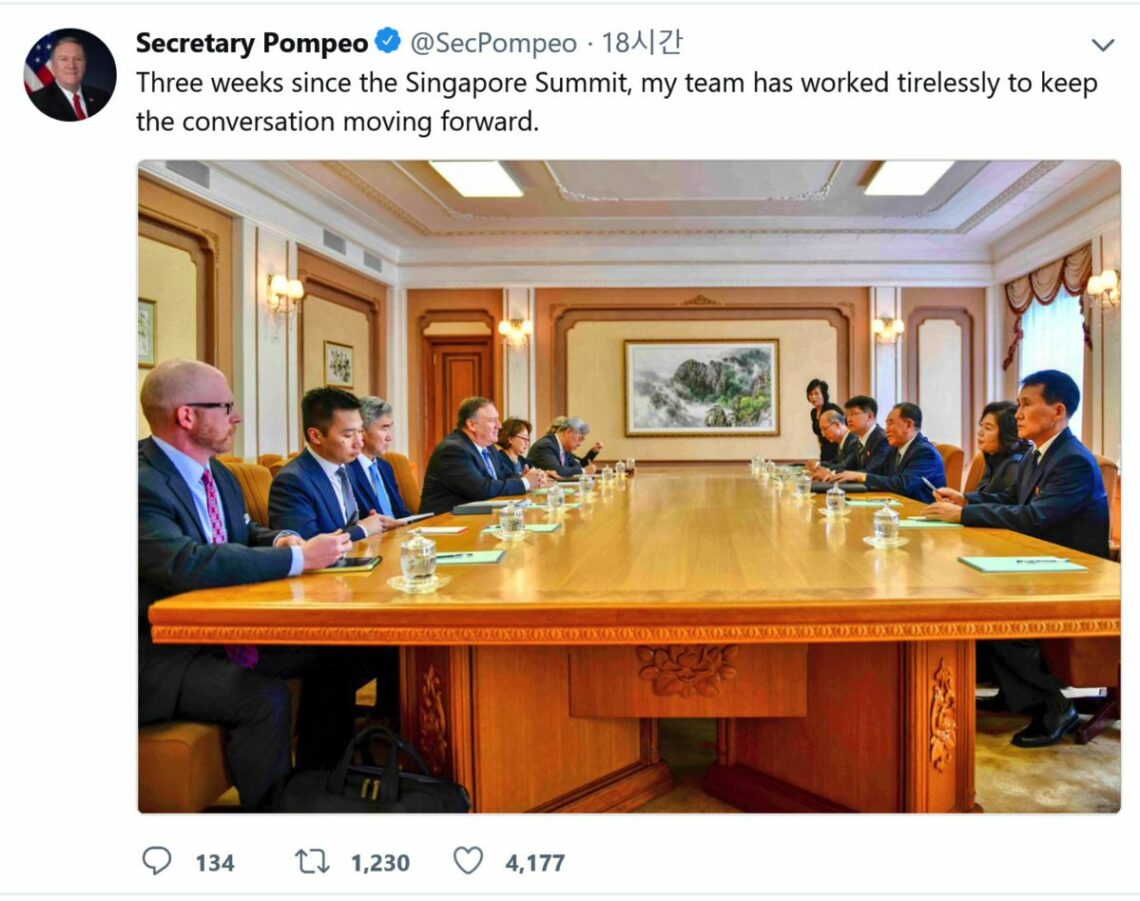Next steps in the North Korea talks
As nuclear talks proceed between the U.S. and North Korea, two sides are pursuing incompatible negotiating strategies. The U.S. wants tangible progress fast, while North Korea is convinced that President Donald Trump is winging it. These opposed courses could soon lead to an impasse. Even so, the conflict escalation remains unlikely.

In a nutshell
- The U.S. is pushing hard for a quick breakthrough on denuclearizing North Korea
- Pyongyang mistakenly believes it can split President Trump from his administration
- The likely result is an impasse and U.S. reversion to “maximum pressure” on Pyongyang
As the nuclear disarmament talks proceed between the United States and the Democratic People’s Republic of Korea (DPRK), there is plenty of evidence to suggest that the negotiating strategies of the two sides are incompatible. These opposed courses could soon lead to an impasse. Even so, the prospects for an escalation of conflict remain low.
After their meeting in Singapore in June, U.S. President Donald Trump confidently pronounced that he and North Korean leader Kim Jong-un would successfully negotiate a diplomatic path forward. President Trump went so far as to declare the DPRK was no longer a nuclear threat.
Since the meeting, there have been conflicting signals from both sides, including inconclusive high-level engagement by U.S. Secretary of State Mike Pompeo.
The view from Washington
For the American side, there is little question that the basic strategy remains unchanged – for now. The U.S. continues to demand the complete, verifiable denuclearization of North Korea, including the dismantling of weapons systems, enrichment, production and research facilities. Fundamentally, the U.S. seeks the “gold standard” in denuclearization, which would require the DPRK to become fully compliant with the obligations of the Nuclear Non-Proliferation Treaty.
Senior U.S. officials have given conflicting versions of a timeline that would be acceptable to the American side. While their statements have varied in detail, they are broadly consistent. Though Washington doesn’t have a fixed schedule, it is clear it is looking for substantive progress in a period of months, not years. As a demonstrable step, the U.S. looks for a clear commitment from Pyongyang to provide a verifiable declaration of all nuclear assets. That is the signal the Americans are waiting for to confirm that North Korea is serious.
At the same time, Washington intends to keep up the “maximum pressure” campaign (nuclear deterrence, missile defense, conventional deterrence in cooperation with South Korea and Japan and sanctions) until it is assured of denuclearization. President Trump’s suspension of joint exercises was not meant as a signal that the U.S. would provide step-by-step incentives for North Korea to continue to negotiate.
Washington intends to keep up the maximum pressure campaign until it is assured of denuclearization.
Within the U.S. government and Congress, there are supporters of a more traditional step-by-step negotiating process, similar to the path pursued by the Bush Administration through the six-power talks. It is clear, however, that senior officials including the president, Secretary of State Pompeo, Defense Secretary James Mattis and National Security Advisor John Bolton do not share that view. Further, as the administration rounds out its team, a number of officials with significant knowledge and experience in arms control have eschewed that approach: notably, National Security Council (NSC) Chief of Staff Fred Fleitz; Tim Morrison, director for arms control and nonproliferation at the NSC; Christopher Ford, assistant secretary for international security and nonproliferation; Yleem Poblete, assistant secretary of state for arms control, verification and compliance; and John Rood, undersecretary for policy at the Defense Department.
The view from Pyongyang
Despite public comments to the contrary, the U.S. government does not believe that North Korea has abandoned its traditional style of seeking rewards and compromises for each stage of the negotiating process. The administration is also not convinced Pyongyang is ready to give up its nuclear weapons.
U.S. officials have the impression that the North Koreans believe President Trump is operating independently from the rest of the government; accordingly, their preferred strategy would be to negotiate the big issues directly with the president. The DPRK has already sent signals that it is interested in another heads-of-state conference. One option suggested was a meeting of the two leaders on the sidelines of the United Nations General Assembly meeting in September 2018.
North Korea is wrong in its assessment that President Trump is operating independently of his administration. In the end, the U.S. negotiating strategy with the DPRK has always been the president’s strategy. Furthermore, there is little evidence to suggest President Trump will cut a backroom deal with Kim Jong-un. The president has now conducted two high-profile summits where he had been expected to make such deals – in Singapore and Helsinki (with Russian leader Vladimir Putin). In both cases, no bargain materialized. There is little to suggest that the president is ready to compromise on denuclearization.

North Korean officials have told Iranian officials and others that they think Mr. Trump is inclined to make a deal. They argue U.S. presidents need foreign policy successes to bolster their position at home. In particular, Pyongyang thinks Mr. Trump wants to go into the midterm elections with a Korean accord or peace declaration in place. This assessment is almost assuredly wrong.
Foreign policy has had a marginal impact on this presidency. Mr. Trump, for example, received immense criticism from his opponents on the right and the left for his press conference at the Helsinki summit, which many perceived as pandering to Mr. Putin and upsetting to important American allies. Yet, in the wake of the summit, Trump’s approval ratings improved to the highest since he took office. There are few indications that foreign policy will be a major consideration for American voters this fall.
The most negative impact that negotiations with North Korea could have on the president’s popularity would be if he accepted what was perceived as a “bad deal.” Another factor weighing on the administration is the U.S. withdrawal from the Joint Comprehensive Plan of Action (JCPOA), commonly known as the nuclear deal with Iran. Having pulled out of one arms accord that he claimed was not good enough, President Trump would get enormous criticism if he cuts a similar or weaker deal with the DPRK. Conversely, some administration officials argue if the U.S. presses for a gold-standard deal with North Korea, this will send the right signal to Iran.
Way ahead
That said, President Trump might well be willing to meet with Mr. Kim again. After all, having received enormous criticism for his meeting with Vladimir Putin, Mr. Trump turned right around and offered him another meeting.
It is noteworthy that the Putin meeting was subsequently pushed back to next year. Clearly, the White House did not want more attention paid to Russia before the midterm elections. Unlike virtually every other foreign policy issue, relations with Russia do resonate with American voters. This is because of the intense partisan bickering over charges of collusion and interference before the 2016 national elections. A meeting with Kim Jong-un, however, would not invite the same scrutiny.
South Korea has not pressured Washington to make compromises but strongly endorses the diplomatic track.
On the other hand, the president has indicated that he intends to direct much of his energy into campaigning for Republican candidates this fall. In that case, a Kim summit would be a huge distraction that would likely produce almost no tangible results.
Allies and diplomacy
The Singapore summit set off alarm bells in Tokyo. Japanese officials peppered their U.S. counterparts with apprehensions over the American negotiating strategy, fearing it might compromise their security. Washington has offered assurances that this is not the case.
South Korea remains hopeful that negotiations will bear fruit. They have not pressured Washington to make compromises but have strongly encouraged the U.S. to stick to the diplomatic track.
There are three possible scenarios for future developments. In the first, the U.S. will quickly lose patience with the lack of progress on North Korea’s denuclearization and, in a manner similar to Trump’s angry letter before the Singapore summit, declare that it is walking away from the negotiating table. Trump might even threaten the DPRK with “fire and fury” again. For now, this seems the least likely course of events.
A second scenario foresees President Trump agreeing to another summit and making a major unconventional move, such as agreeing to a declaration ending hostilities. That is also unlikely. The two leaders might meet, but the results of the meeting would probably be inconclusive.
The third and most likely scenario is that the Trump administration will let negotiations play out for a few months and then, when they collapse, go back to relying exclusively on the maximum pressure campaign to protect the interests of the U.S. and its allies.
There are significant wild cards. Kim Jong-un could reinstitute provocative actions such as missile tests. The U.S. would inevitably respond, though it is extremely improbable that such a tit for tat would escalate into armed conflict.
Another possible wild card is that the DPRK genuinely commits to denuclearization. The U.S. would then have to assemble the resources needed to implement the process and deal with the cascading issues that might result, including the impact of a North Korean settlement on relations with China and the U.S. military posture in Northeast Asia.







